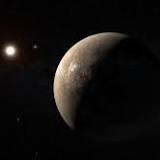Haunting audio from a black hole allows humans to hear the sounds of space 240 million light-years away

Is there sound in space? New audio released from NASA provides some insight – and the answer is haunting.
The audio, released on May 4, is that of a black hole from the center of the Perseus galaxy cluster, a massive space structure that's 11 million light-years across and located about 240 million light-years away from Earth. Astronomers created the audible sound by recording the pressure waves that the black hole sent through the cluster's hot gas. In their original form, those waves cannot be heard by the human ear, so scientists extracted the sound waves and scaled them up by 57 and 58 octaves.
"In some ways, this sonification is unlike any other done before," NASA said in a release. "...[The sound waves] are being heard 144 quadrillion and 288 quadrillion times higher than their original frequency."
When bumped up to human frequencies, the sounds of the black hole are almost akin to the wails of a haunting ghost or the deep ocean calls of a pod of whales.
While this particular sound of space is new, NASA has associated the Perseus galaxy cluster with sound since 2003. Galaxy clusters like Perseus are the largest gravitationally bound objects in the universe containing hundreds of galaxies, massive clouds of hot gas that reach more than 180 million degrees Fahrenheit and the ever-mysterious dark matter. All of that material creates a medium for sound waves to travel.
Along with releasing the sounds of Perseus, NASA scientists have also released a sonification of another famous black hole located in Messier 87, or M87.
Unlike Perseus' black hole, this one has a far higher pitch, and can best be described as ambient music with light chimes. The visualization of the sound that NASA released is just as spectacular, as it contains scans of the black hole taken by the Chandra X-ray Observatory, optical light from Hubble Space Telescope and radio waves from the Atacama Large Millimeter Array in Chile. It also contains an image of where the black hole is located and an image of a jet that M87 has produced.
The audio files and visualizations were released during NASA's Black Hole Week from May 2 to 6. During that time, NASA released various visualizations and information about black holes as part of a "celebration of celestial objects with gravity so intense that even light cannot escape them."

Li Cohen is a social media producer and trending reporter for CBS News, focusing on social justice issues.


 United Kingdom
United Kingdom Argentina
Argentina  Australia
Australia  Austria
Austria  Brazil
Brazil  Canada
Canada  Germany
Germany  Ireland
Ireland  Italy
Italy  Malaysia
Malaysia  Mexico
Mexico  New Zealand
New Zealand  Poland
Poland  South Africa
South Africa  United States
United States 























